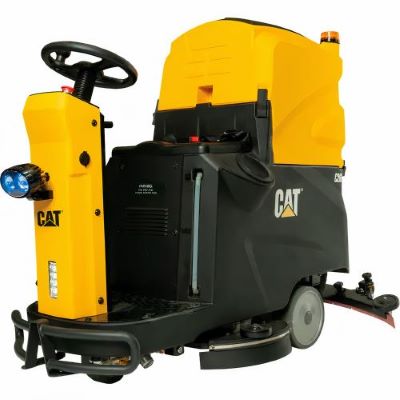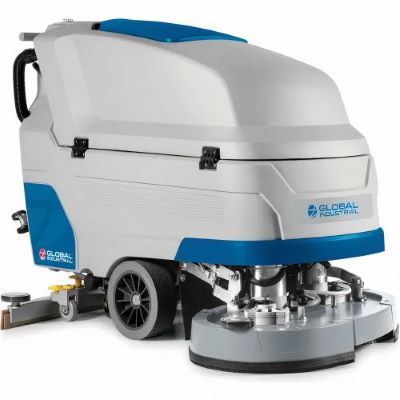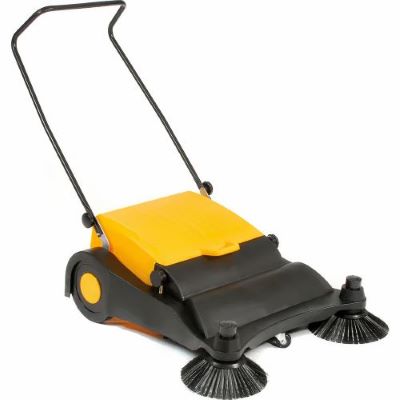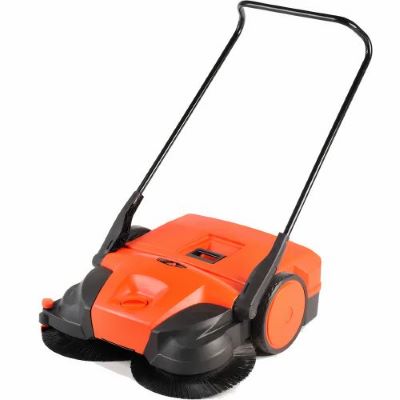Look down. How often do you think about your floors? Clean floors are literally the foundation of your business. A spotless floor is the key to safety and efficiency. Your electric floor scrubber is your primary tool for keeping your floors clean and polished without having to break out the old mop and bucket. Just like your car needs proper maintenance and care for optimal performance, so does your floor machine. So take care of the machines that take care of you (and your floors).
So how do you keep your floor cleaning machine performing at its best? In short, it’s all about proper maintenance and care. Here, we present the five most common floor scrubber machine issues that come up with tips to troubleshoot. But first, let’s explore the three types of floor scrubbers to ensure you are using the right scrubber for your needs:
TYPES OF FLOOR SCRUBBERS
Ride-On Floor Scrubbers
A ride-on industrial floor cleaner allows for increased productivity and coverage over larger areas. It can clean up to 73,000 square feet an hour and features cleaning widths of up to 40 inches. Ideal for warehouses, schools, hospitals, and more..
Walk-Behind Floor Scrubbers
Manually operated and more maneuverable for smaller spaces, these machines vary in size and cleaning paths with widths range from 13-34 inches. Cylindrical machines are able to sweep and scrub at the same time with adjustable brush pressure options, a built-in squeegee, and a vacuum system whereas A compact orbital scrubbers oscillate in tight, fast vibrations instead of rotations. This makes it great to clean large, flat surfaces like concrete, tile, or vinyl floors.
Floor Machines
Smaller and more agile, the hand-operated floor machines are equipped for high-powered scrubbing, buffing, polishing, or stripping of various surfaces including hard floors, tile, and carpets. They offer versatility but may require more operator skill.
Compact Floor Scrubbers
Designed to clean tough messes in tight spaces and hard-to-reach corners, featuring cleaning path widths up to 14 inches. Battery-powered compact floor scrubber machines have various run times of up to 4 hours per charge while corded scrubber models allow for nonstop cleaning.
TOP 5 FLOOR SCRUBBER PROBLEMS (AND SOLUTIONS)
| Problem | Solutions |
|---|---|
| PROBLEM 1: My floor isn’t getting fully cleaned! | • Make sure you are using the correct chemicals for the floor type. • Clear your squeegees of lint, dirt, and debris. • Inspect the squeegees for cracks and missing chunks for replacement. • Check the pads and brushes for wear, replace with properly fitted types. |
| PROBLEM 2: My scrubber is not sucking up liquid! | • Clear any clogs under the squeegees bar or in the hose. • Adjust operating speed, particularly on tile floors with grout lines. • Modify the liquid dispersion amount. • Push the vacuum reset button. |
| PROBLEM 3: My scrubber keeps quitting on me! | • Ensure the battery is fully charged. (give ample time on a recharge) • Check if the dirty water reservoir is full and potentially triggering the ball check valve closure. • Test the machine with a different outlet to ensure proper electrical contact. • Push the reset button for a fresh start. |
| PROBLEM 4: My scrubber is not releasing liquid! | • Adjust the chemical flow at the valve. • Check the clean water reservoir for debris or clogs. • Inspect and clean the strainer in the tank. • Ensure hoses are not clogged. |
| PROBLEM 5: My scrubber smells bad! | • Empty and rinse the dirty water reservoir after each use. • Prop open the dirty water reservoir during charging to allow gasses to escape. • Regularly change pads and brushes. |
Don’t Slip Up - Utilize Prevention
The best way to solve a scrubber issue is to prevent a scrubber issue. Focus on three key maintenance aspects to make sure your floor cleaning equipment continues to operate efficiently.
1. Replacement Pads/Scrubs: Regularly replace worn-out pads or scrubbers to maintain effective cleaning performance. Choose the right type of pads for different floor surfaces and applications.
2. Replacement Squeegee: Well-maintained squeegees are crucial for proper water pickup. Replace damaged or worn squeegees promptly to prevent streaks and ensure a dry floor.
3. Replacement Battery: A well-functioning battery is essential for uninterrupted operation. Follow proper charging practices and replace worn-out batteries to extend the life of your floor scrubber.
All of your consumable Pack & Ship, Cleaning, and Safety supplies can be found and re-ordered in our easy-to-navigate Restock Station. For additional information on Global Industrial™ floor machine maintenance, service and support or to request a service call, please visit the Floor Care Machines Service Portal.
By practicing smart prevention techniques, you can keep your commercial floor scrubber humming and ensure the only mess you have to deal with is… the mess you have to deal with.
The information contained in this article is for informational, educational, and promotional purposes only and is based on information available as of the initial date of publication. It is the reader’s responsibility to ensure compliance with all applicable laws, rules, codes and regulations. If there is any question or doubt in regard to any element contained in this article, please consult a licensed professional. Under no circumstances will Global Industrial® be liable for any loss or damage caused by your reliance on this article.



